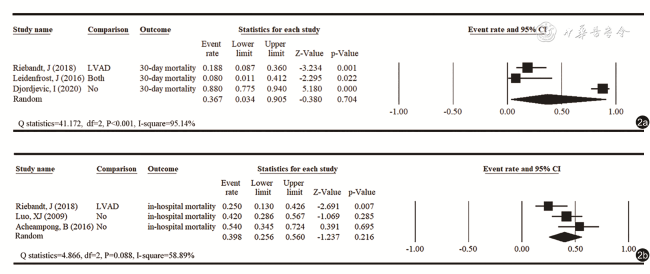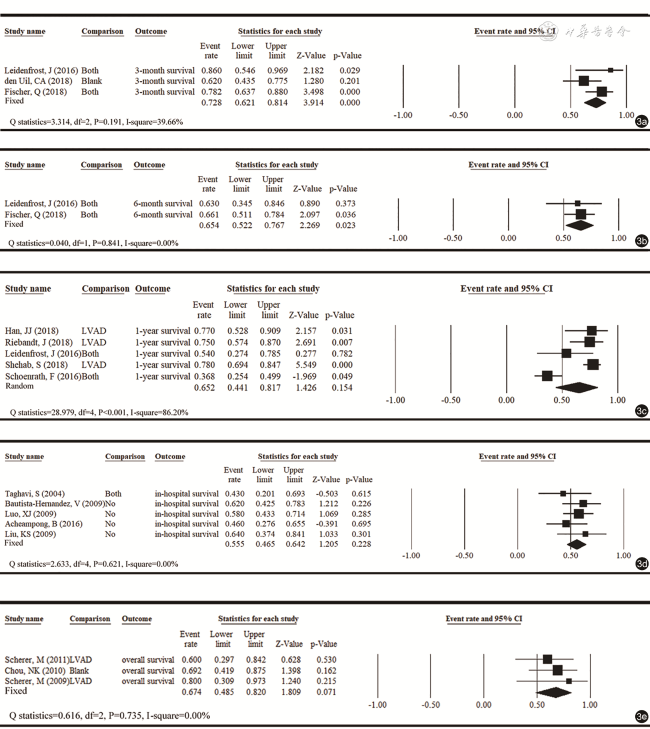对象与方法
一、文献检索
(一)计算机检索
(二)手工检索
二、文献纳入及排除标准
(一)纳入标准
(二)排除标准
三、数据提取及文献质量评价
四、统计学分析
结果
一、文献检索结果及纳入文献基本信息
表1 纳入研究及患者的基本特征信息 |
| 研究者 | 年份 | 辅助装置 | 例数 | 年龄(岁) | 男性比例[例(%)] | 病死率 | 生存率 |
|---|---|---|---|---|---|---|---|
| Djordjevic,I | 2020 | 无 | 64 | 63±14 | 42(68) | 1个月病死率88% | - |
| Riebandt,J | 2018 | 左心室辅助 | 32 | 52±14 | 27(84.4) | 1个月病死率18.8%,住院病死率25% | 1年生存率75% |
| den Uil,CA | 2017 | - | 29 | 40±16 | 12(41) | 3个月病死率38% | 3个月生存率62% |
| Fischer,Q | 2018 | 左心室辅助+右心室辅助 | 44 | 58.2±12.3 | 38(86) | - | 1、3、6个月生存率 88.4%,78.2%,66.1% |
| Shehab,S | 2018 | 左心室辅助 | 112 | 51±14 | 90(80) | - | 1年生存率78% |
| Han,JJ | 2018 | 左心室辅助 | 18 | 54±16 | 14(78) | - | 1年生存率77% |
| Leidenfrost,J | 2016 | 左心室辅助+右心室辅助 | 12 | 45.6±16 | - | 1个月病死率8% | 3、6个月、1年生存率 86%,63% and 54% |
| Schoenrath,F | 2016 | 左心室辅助+双心室辅助 | 57 | 46.8±15.5 | 13(43.3) | - | 1、2、4年生存率6.8%,32.2% and 29.8% |
| Acheampong,B | 2016 | 无 | 24 | 41(22~75) | 14(58.3) | 住院病死率54% | 住院生存率 46% |
| Noly,PE | 2014 | 左心室辅助 | 8 | 50.8±9.9 | 5(62.5) | 病死率50.00% | - |
| Scherer,M | 2011 | 左心室辅助 | 10 | 53±10 | 9(90) | - | 总生存率60% |
| Chou,NK | 2010 | - | 14 | - | - | - | 总生存率69.2% |
| Bautista-Hernandez,V | 2009 | 无 | 26 | 0.12(0~193)* | 18(69) | - | 住院生存率62% |
| Luo,XJ | 2009 | 无 | 45 | 49.0±14.1 | 34(76) | 住院病死率42% | 住院生存率58% |
| Scherer,M | 2009 | 左心室辅助 | 5 | 47±11 | 4(80) | - | 总生存率80% |
| Liu,KS | 2009 | 无 | 14 | 55.7±15.4 | 7(50) | - | 住院生存率64% |
| Taghavi,S | 2004 | 左心室辅助+右心室辅助 | 13 | 51.3±15.6 | 10(77) | - | 住院生存率43% |
| Smedira,NG | 2001 | 无 | 202 | 55±14 | 145(72) | - | 1个月、1年生存率8%,24% |
注:“*”单位为个月;“-”代表无数据 |
二、文献质量评价
表2 文献NOS量表评分(分) |
| 研究者 | 年份 | 对象的选择 | 群体可比性 | 结局评估 | 合计 | |||||
|---|---|---|---|---|---|---|---|---|---|---|
| 1* | 2* | 3* | 4* | 5* | 6* | 7* | 8* | |||
| Djordjevic,I | 2020 | 1 | 0 | 1 | 1 | 1 | 1 | 1 | 1 | 7 |
| Riebandt,J | 2018 | 1 | 0 | 1 | 1 | 1 | 2 | 1 | 1 | 8 |
| den Uil,CA | 2018 | 1 | 0 | 1 | 1 | 1 | 1 | 0 | 1 | 6 |
| Fischer,Q | 2018 | 1 | 0 | 1 | 1 | 1 | 0 | 1 | 1 | 6 |
| Shehab,S | 2018 | 1 | 0 | 1 | 1 | 1 | 1 | 1 | 0 | 6 |
| Han,JJ | 2018 | 1 | 0 | 1 | 1 | 1 | 1 | 1 | 1 | 7 |
| Leidenfrost,J | 2016 | 1 | 0 | 1 | 1 | 1 | 1 | 1 | 0 | 6 |
| Schoenrath,F | 2016 | 1 | 0 | 1 | 1 | 1 | 2 | 1 | 1 | 8 |
| Acheampong,B | 2016 | 1 | 0 | 1 | 1 | 1 | 1 | 1 | 1 | 7 |
| Noly,PE | 2014 | 1 | 0 | 1 | 1 | 1 | 1 | 1 | 0 | 6 |
| Scherer,M | 2011 | 1 | 0 | 1 | 1 | 1 | 1 | 1 | 0 | 6 |
| Chou,NK | 2010 | 1 | 0 | 1 | 1 | 1 | 1 | 0 | 1 | 6 |
| Bautista-Hernandez,V | 2009 | 1 | 0 | 1 | 1 | 1 | 1 | 1 | 0 | 6 |
| Luo,XJ | 2009 | 1 | 0 | 1 | 1 | 1 | 1 | 1 | 1 | 7 |
| Scherer,M | 2009 | 1 | 0 | 1 | 1 | 1 | 1 | 1 | 1 | 7 |
| Liu,KS | 2009 | 1 | 0 | 1 | 1 | 1 | 2 | 1 | 1 | 8 |
| Taghavi,S | 2004 | 1 | 0 | 1 | 1 | 1 | 1 | 1 | 1 | 7 |
| Smedira,NG | 2001 | 1 | 0 | 1 | 1 | 1 | 2 | 1 | 1 | 8 |
注:1*为暴露队列的代表性;2*为非暴露队列的选择;3*为暴露确认;4*为研究开始前没有研究对象发生结局事件;5*为基于设计或分析所得的队列的可比性;6*为结局事件的评估;7*为观察到结局发生,随访是否充分;8*为随访的完整性 |
三、1个月病死率及住院病死率分析
四、3个月、6个月、1年存活率,住院存活率及总存活率分析
五、敏感度分析
表3 病死率的敏感度分析 |
| 结果 | 文献 | 统计结果 | ||
|---|---|---|---|---|
| 分数 | 95%CI | P值 | ||
| 1个月病死率 | Riebandt,J(2018) | 0.472 | 0.011~0.986 | 0.959 |
| Leidenfrost,J(2016) | 0.568 | 0.043~0.975 | 0.874 | |
| Djordjevic,I(2020) | 0.166 | 0.081~0.311 | 0.000 | |
| 合并计算(随机模型) | 0.367 | 0.034~0.905 | 0.704 | |
| 住院病死率 | Riebandt,J(2018) | 0.462 | 0.348~0.580 | 0.530 |
| Luo,XJ(2009) | 0.385 | 0.154~0.682 | 0.456 | |
| Acheampong,B(2016) | 0.340 | 0.195~0.523 | 0.085 | |
| 合并计算(随机模型) | 0.398 | 0.256~0.560 | 0.216 | |
表4 存活率的敏感度分析 |
| 结果 | 文献 | 统计结果 | ||
|---|---|---|---|---|
| 分数 | 95%CI | P值 | ||
| 3个月生存率 | Leidenfrost,J(2016) | 0.711 | 0.595~0.805 | 0.001 |
| den Uil,CA(2018) | 0.796 | 0.670~0.883 | 0.000 | |
| Fischer,Q(2018) | 0.673 | 0.510~0.803 | 0.038 | |
| 合并计算(固定模型) | 0.728 | 0.621~0.814 | 0.000 | |
| 6个月生存率 | Leidenfrost,J(2016) | 0.661 | 0.511~0.784 | 0.036 |
| Fischer,Q(2018) | ||||
| 0.630 | 0.345~0.846 | 0.373 | ||
| 合并计算(固定模型) | 0.654 | 0.522~0.767 | 0.023 | |
| 1年生存率 | Riebandt,J(2018) | 0.626 | 0.364~0.830 | 0.348 |
| Leidenfrost,J(2016) | 0.675 | 0.430~0.851 | 0.157 | |
| Shehab,S(2018) | 0.608 | 0.372~0.802 | 0.371 | |
| Schoenrath,F(2016) | 0.752 | 0.677~0.815 | 0.000 | |
| Han,JJ(2018) | 0.624 | 0.377~0.820 | 0.325 | |
| 合并计算(随机模型) | 0.652 | 0.441~0.817 | 0.154 | |
| 住院生存率 | Taghavi,S(2004) | 0.570 | 0.475~0.660 | 0.147 |
| Bautista-Hernandez,V(2009) | 0.538 | 0.437~0.636 | 0.464 | |
| Luo,XJ(2009) | 0.540 | 0.427~0.650 | 0.485 | |
| Acheampong,B(2016) | 0.579 | 0.479~0.673 | 0.122 | |
| Liu,KS(2009) | 0.545 | 0.449~0.637 | 0.361 | |
| 合并计算(固定模型) | 0.555 | 0.465~0.642 | 0.228 | |
| 总生存率 | Scherer,M(2011) | 0.717 | 0.481~0.874 | 0.070 |
| Chou,NK(2010) | 0.657 | 0.391~0.851 | 0.244 | |
| Scherer,M(2009) | 0.652 | 0.446~0.814 | 0.144 | |
| 合并计算(随机模型) | 0.674 | 0.485~0.820 | 0.071 | |





